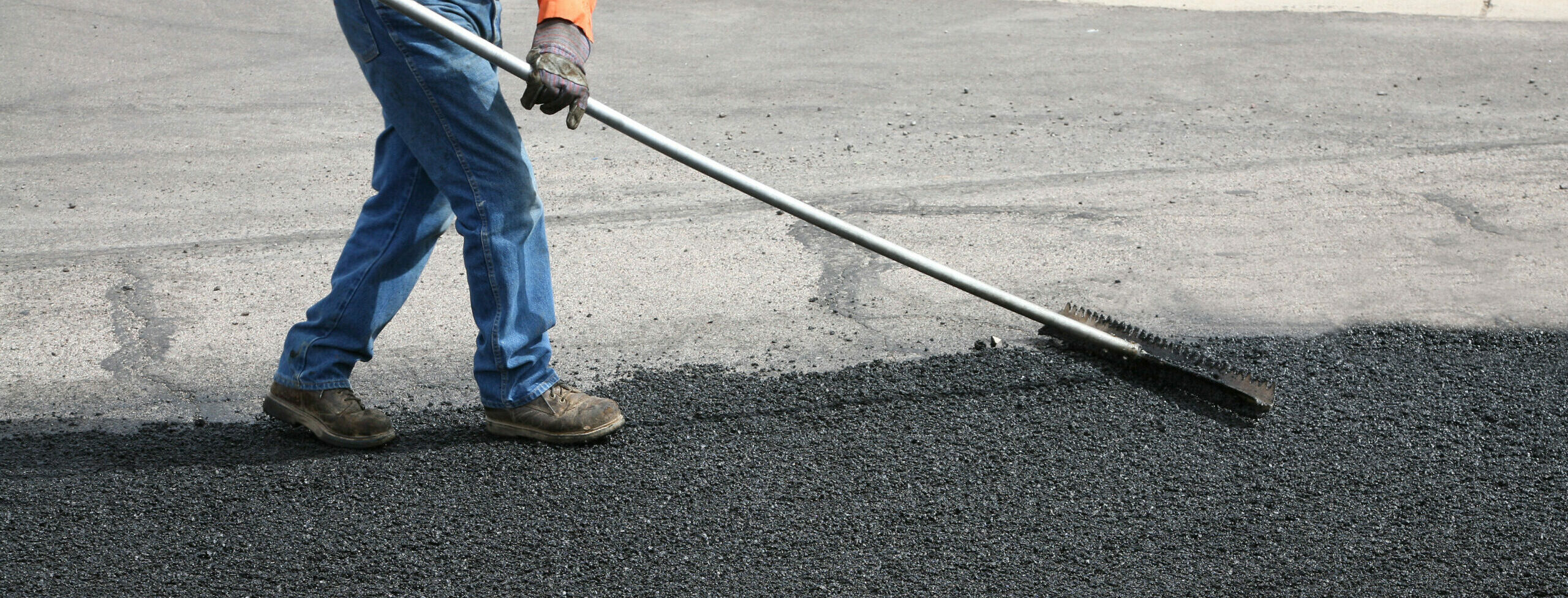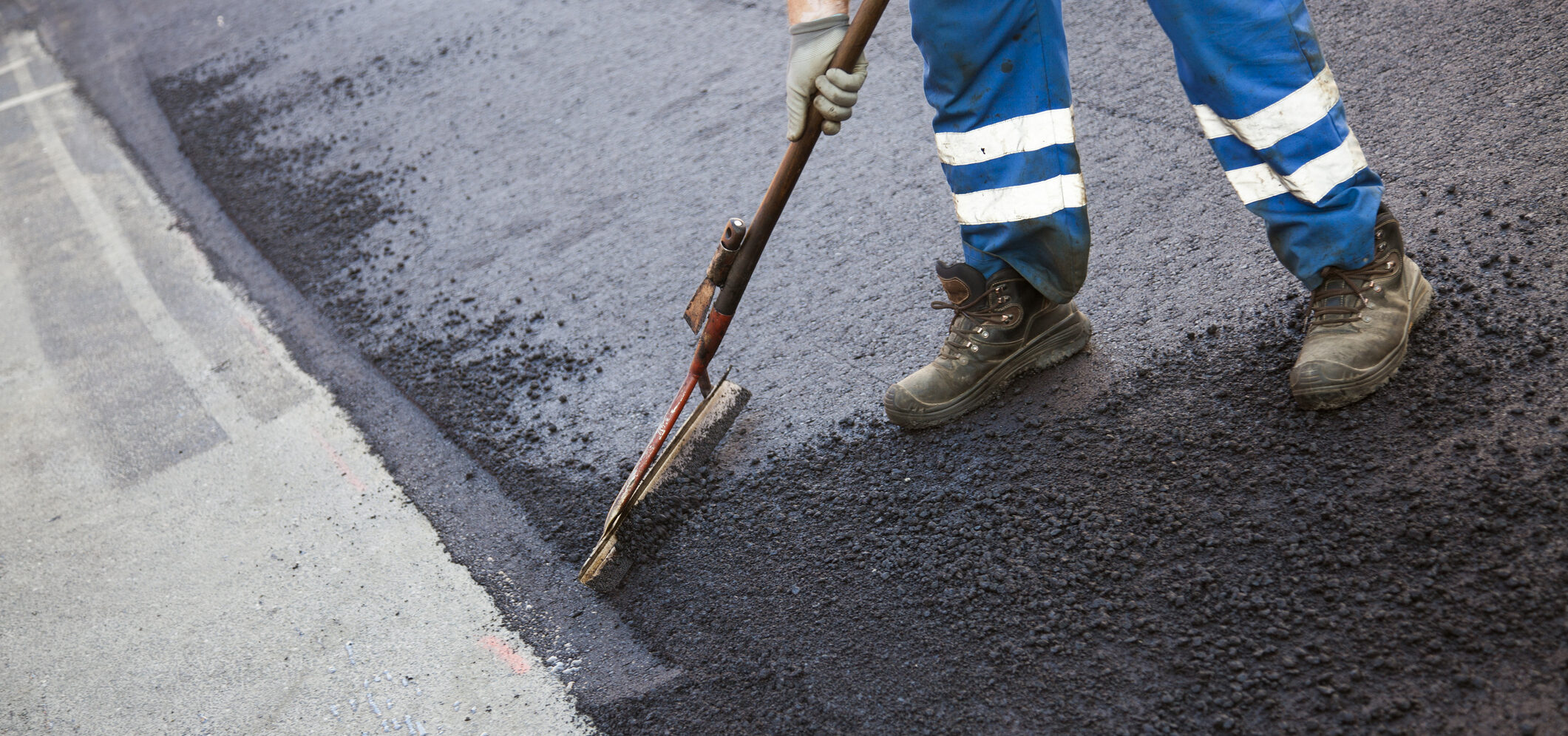Below, we’ll shed light on the crucial differences between these materials, focusing not just on their physical attributes but also on the varied maintenance they demand. By examining factors such as climate suitability, repair methods, and lifespan, this blog will equip you with the knowledge necessary to choose the right material for your pavement needs and understand how to best maintain it over time.
Continue reading below to uncover the unique benefits and maintenance tips for asphalt and concrete and discover why McConnell & Associates is your trusted partner in concrete and asphalt service excellence.

What is Asphalt Pavement?
Asphalt pavement represents a significant portion of the United States’ infrastructure, serving as the backbone of our transportation network. In essence, asphalt pavement is a combination of aggregates, such as rock, sand, and gravel, bound together by bitumen, a sticky, black, and highly viscous liquid. This blend creates a durable surface that accommodates a variety of uses, including highways, parking lots, and driveways.
While both asphalt pavement and concrete surfaces require upkeep, asphalt maintenance can be less intensive and more cost-effective in the long run. For instance, strategies like sealcoating, crack filling, and resurfacing contribute to the proper maintenance of asphalt vs concrete surfaces, often resulting in a longer service life for asphalt, especially when subjected to heavy-duty use.
Sealcoating: Applied periodically, sealcoating helps to protect the asphalt surface from oxidation and weather damage.
Crack filling/crack sealing: A preventative measure that mitigates water infiltration, which is the primary cause of base deterioration.
Patching: Offers a remedy for potholes, damaged asphalt and restoring surface integrity and user comfort.
Resurfacing: Imparts a new life to old asphalt, making it more resilient to wear and tear.
What is Concrete Pavement?
Concrete pavement has long been a staple in both urban and rural infrastructure, serving as the foundation for roads, walkways, and a variety of other surfaces. Consisting of a mixture of cement, water, and aggregates such as sand and gravel, concrete creates a firm and durable surface suitable for a range of applications.
Additionally, concrete can bear heavy loads, which is essential in high-traffic commercial areas or industrial sites. These strengths make concrete an ideal choice for projects where longevity and hardiness are crucial and often outperform asphalt in these specific application scenarios.
Concrete’s sturdy nature makes it ideal for environments that endure heavy traffic or require a surface that can withstand significant weight and pressure.
The durability of concrete surfaces reduces the frequency of required maintenance, representing long-term cost savings.
Though less flexible than asphalt, concrete can better resist certain types of stress, offering a rigid solution for various structural purposes.
Cost Difference Between Asphalt and Concrete
Understanding the initial and long-term financial implications of asphalt and concrete materials is crucial. Both materials offer unique benefits, but their costs can significantly impact your project’s budget.
Comparing Initial Installation Costs
The choice between asphalt and concrete often hinges on up-front costs. Typically, you’ll find that asphalt has a lower initial installation cost due to its less expensive raw materials and faster laying process.
Concrete, on the other hand, involves higher material costs and a longer curing time, which can translate to higher initial labor costs as well. This is a pivotal factor to consider in the cost difference between asphalt and concrete.
Long-Term Maintenance Expenses
Moving beyond the initial investment, you’ll encounter varying maintenance costs over time. Asphalt surfaces usually require more frequent short-term maintenance, such as sealcoating every 2-5 years to prevent cracking and oxidation.
Concrete’s maintenance, while less frequent, can sometimes involve more extensive repairs if issues like cracking or spalling occur. These long-term care requirements significantly influence the overall cost difference between asphalt and concrete, making it essential to factor in maintenance when considering total expenses.
Cost-Effectiveness of the Pavement’s Lifespan
When considering the long-term value, you need to evaluate which pavement offers greater cost-effectiveness over its lifespan. Asphalt, though cheaper to install, may demand more maintenance over time. Concrete, while pricier upfront, often showcases greater longevity, potentially leading to lower costs over the life of the pavement if maintained appropriately.
The balance between the two materials’ lifespan, repair frequency, and ongoing maintenance costs is a major determinant in the overall cost-effectiveness of asphalt vs concrete maintenance. Ultimately, by carefully considering these factors, you’ll be better prepared to make a decision that aligns with your long-term financial objectives.

How Weather Conditions Affect Asphalt and Concrete
Temperature fluctuations can cause both asphalt and concrete pavements to expand and contract, sometimes leading to damage. Asphalt, with its black surface, can absorb heat and become pliable, making it susceptible to softening and rutting in extreme heat, while in cold climates, its flexibility allows it to resist cracking better than concrete. In contrast, concrete can crack with temperature swings, especially when they are sudden and severe, but it maintains its form well in high heat without becoming soft.
Freeze-thaw cycles also influence the maintenance requirements of pavements. The accumulative effect of successive freeze-thaw cycles can eventually cause expansion, cracking, scaling and crumbling of concrete as well as asphalt. When temperatures are above freezing, rainwater or snowmelt will make its way into any small crack in the pavement.Then, as temperatures drop below freezing, the water within the crack pavement begins to freeze and expand, causing the crack to expand and grow as well. Then as temperatures rise, these ice lenses will begin to melt, weakening the base layer and leaving large voids where the ice lenses are formed. Heavy loads can then greatly damage the pavement and even cause potholes to quickly form. Severe weather events can also expedite damage, requiring more immediate maintenance to address weathering effects.
Choosing the Right Material for Your Project
When faced with the decision of selecting the best paving material for your project, it’s essential to weigh the benefits of asphalt vs concrete. Your choice should be guided by a thoughtful consideration of your budget, anticipated usage, and the specific climate conditions of your locale. It’s not merely an asphalt or concrete question—it’s an assessment of how either material will perform in your unique situation over time.
Here are the key factors to help steer your decision-making process.
Cost Efficiency: If the initial budget is a pivotal concern, asphalt typically offers a more cost-effective option for both installation and short-term maintenance.
Lifespan and Durability: For projects where longevity is a priority, consider the longer life expectancy of concrete. However, if flexibility and resistance to cold climate cracking are more important, asphalt may be the more suitable choice.
Maintenance and Repairs: Factor in the frequency and type of maintenance routines you are prepared to manage. Asphalt will require regular sealcoating and attention, while concrete demands less frequent but potentially more intensive repairs.
Climate Resilience: Analyze local weather patterns and temperature fluctuations. Asphalt can withstand colder temperatures and adapt to changing conditions without cracking. Conversely, concrete stands up better to heat and heavy loads but can be prone to damage from freeze-thaw cycles.
Usage Patterns: Anticipate the level and type of traffic your pavement will encounter. High-traffic scenarios may sway you towards concrete for its ability to handle heavy loads without rutting, whereas asphalt can be advantageous in areas where lower impact but higher volume traffic is expected.
Environmental Impact: Sustainability considerations are increasingly urgent. In the debate on the environmental impact of asphalt vs concrete, remember asphalt’s recyclability and the move towards greener concrete mixtures.
Discover the Best in Professional Concrete & Asphalt Services with McConnell & Associates
No matter which material you choose, it’s essential to understand your immediate needs as well as your project’s long-term requirements. The benefits of asphalt vs concrete are uniquely varied, and the choice should resonate with your overarching goals for usage, resilience, aesthetic preference, and fiscal responsibility. Whether it’s an expansive commercial lot or a residential driveway, the decision between asphalt or concrete will be a defining factor for the success and sustainability of your paving project.
At McConnell & Associates, we understand that choosing the right material for your pavement needs is a significant decision. Our decades of experience in both concrete and asphalt, as well as athletic surface services, make us the go-to experts in the Midwest.
Whether it’s the durable allure of asphalt or the classic elegance of concrete, we have the expertise to guide you through. Our dedicated team is committed to providing not only top-quality service but also insightful advice to help you make informed decisions about pavement maintenance.
Contact McConnell & Associates today to discover how our tailored solutions can enhance the longevity and aesthetic of your pavements. Let us help you navigate the complexities of asphalt and concrete maintenance with ease and confidence.


.png)


